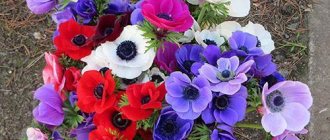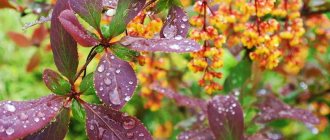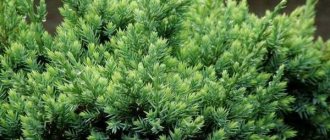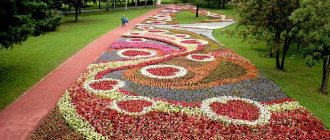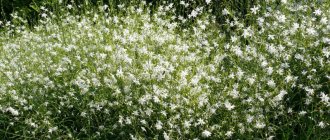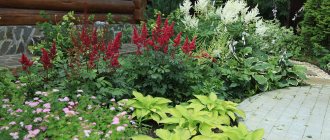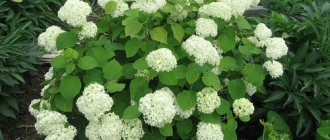Luxurious summer flower beds, immersed in a riot of colors, are certainly pleasing to the eye. You can admire them, rejoice at every new flower, but... Agree, they are not the ones that cause special, incomparable delight. Modest primroses, appearing as soon as the warm spring sun warms the earth, are what can evoke in the soul a feeling of real magic associated with the arrival of spring. Even a small flower garden, combined from plants that bloom from March to May, will become the best decoration for the site in the spring. Therefore, you should not deny yourself this pleasure, especially since the choice of plants for spring flower beds is huge.
Spring flower beds are distinguished by rich colors and bright blooms.
Bulbous plants are the first “stars” of the spring flower garden
The basis of the spring flower garden most often consists of bulbous plants. It is they who, preserving reserves of nutrients and water in their bulbs in winter, “shoot out” delicate flowers at the beginning of spring. Moreover, some of the bulbous plants do not particularly care about the growing season - the buds grow from the bulbs immediately, along with the first leaves. This is how, for example, crocuses behave, the most popular plants in spring flower beds.

Crocuses - flowers from under the snow
Various varieties with white, violet, lilac or yellow flowers can form a picturesque clump in a spring flower bed or simply under a tree. The undeniable advantage of low-growing spring bulbs, which include crocuses, is their small root system, which allows them to be planted among the roots of powerful trees. In addition, their flowering coincides with the period when there are no leaves on the trees yet. This means that no obstacle will prevent the penetration of sunlight under the openwork network of branches.
A little later than the crocuses, blue muscari flowers bloom in the spring flower bed. They look especially advantageous in crowded groups, for example, as a border or small flower islands among other bulbous plants.

Armenian muscari has a subtle pleasant aroma that attracts bees and butterflies
In March-April, scillas (scillas) - small bulbous plants from the lily family that form multi-flowered clusters of white, blue, and pink colors - will be able to decorate the spring flower garden.

Due to their bell-shaped flowers, scillas are sometimes called blue snowdrops
Against the background of small bulbous plants, tulips and daffodils will look advantageous. Among them there are botanical (natural) species - low-growing, with small flowers. Their advantage is that they bloom already in April, 2-3 weeks earlier than their varietal counterparts.

Tulips and daffodils are the most popular plants in spring flower gardens
Container flower beds with primroses
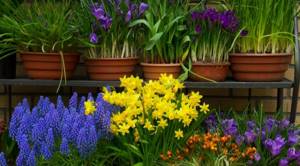
Mobile flower beds made from spring-flowering bulbous plants do not decorate the garden for long, but can become one of the brightest accents of the spring garden. In addition, they are very comfortable. An effective container flower garden can be made using a very small number of bulbs: this way you will significantly save planting material.
Tulips, hyacinths, and crocuses are usually planted in containers at the same time as in open ground, and in the spring the pot is inserted into a decorative container of a suitable size and placed in a visible place. This method allows you to place flowering plants anywhere, for example next to a path on a stand, so that their aroma is better distributed. Fading plants can be moved along with the container to a distant corner of the garden and allowed to complete their seasonal development cycle, and summer plants can be planted in the free space: petunia, ageratum, asters, etc.
Growing bulbous plants in containers provides a number of other advantages: the bulbs are reliably protected from rodents. At the end of flowering, the bulbs can be easily “dug up” without fear of damage. Even the smallest bulbs in containers will never get lost.
In the spring, you can decide how you will grow your plants: bury plastic containers in the garden or place them on the terrace, gazebo or garden path.
Perennials are permanent residents of the spring flower garden
Unfortunately, most bulbous plants are beautiful only at the flowering stage. After the flowers fade, the foliage invariably withers, which does not add aesthetics to the flower garden. That is why it is advisable to plant beautifully flowering perennials next to the bulbous ones, which will adequately combine with the bulbous ones during their flowering, and after that they will cover the resulting voids.
An excellent partner for crocuses, muscari, and scillas will be spring flowers, opening the cups of yellow flowers already in early spring. It grows quickly, covering the ground with a blooming, fragrant carpet.

Vesennik can begin to grow while still under the snow
At the same time, various types of hellebore begin to bloom, which have a truly Nordic character - they are not afraid of even frost.

Large hellebore leaves after flowering can cover the withered foliage of bulbous plants.
In almost every spring flower garden there is a place for irises - flowers of unusual beauty. For early flowering, choose the reticulated iris, a low-growing herbaceous species that blooms from March to April. Bearded irises are more suitable as bright, dominant plants in a spring flower garden - they bloom in mid-to-late May.

Iris reticulum is an early flowering plant.
Perennial flowers blooming in early spring
March is always associated with the absence of beauty in the area. But by planting flowering plants, this problem can be solved. Let's look at several crops that are ideal for growing in early spring.
Delicate snowdrops
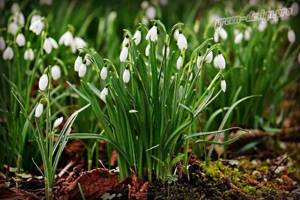
Snowdrops are perennial flowers that greet the first rays of the spring sun. Snowdrops emerge in the garden in early March, when there may still be snow in the dark, secluded corners of the garden. It loves sunlight, so when choosing a place to plant, find an area that will be well lit and not shaded by other plants. The plant is not fussy about soil; ordinary garden soil will do. When creating flower arrangements using snowdrops, keep in mind that its outer part quickly dies off after flowering, and the flower bed in these places will not look very neat.
The plant is planted in the fall using bulbs or ripened seeds. Once you've planted a few bulbs, be prepared to have your entire lawn covered in snowdrops in a few years. It grows rapidly, and the seeds, carried by insects, quickly take root in the nearby area.
Magnificent crocuses
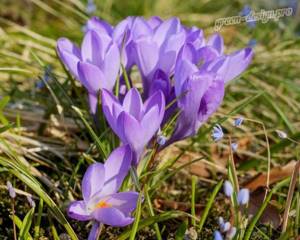
Crocuses are perennial specimens, some of the varieties bloom in February. A large number of varieties bred by breeders allows you to choose the most suitable option for your garden. For example, Dutch hybrids have large buds that look good in garden compositions and container plantings.
The plant is planted in the fall using bulbs. When planting, it is recommended to use a special net for the bulbs. It will protect the plant from rodents, which often feast on tubers, and will help compactly preserve planting material. Crocus is unpretentious and can grow well in partial shade or in sunny areas.
Mouse hyacinth or viper onion

A plant of amazing exotic beauty. Thanks to the wide variety of varieties, you can choose the most suitable option for your garden. Hyacinth blooms in early April and reproduces by bulbs. An onion planted in the fall will produce a large number of small onions next year, thanks to which the plant quickly grows throughout the garden. To control reproduction, a special mesh (basket) is used in which the bulb is planted.
Hyacinth is used to create group plantings. Early perennial garden flowers combined with viper's onion create unique flower beds. If you select several different varieties of hyacinth with different flowering periods, you can create a unique flower bed that blooms almost until the end of summer.
Sanguinaria canadensis or bloodroot
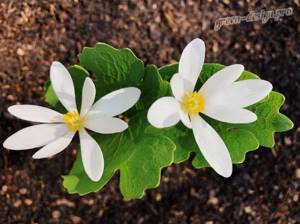
Sanguinaria is a perennial, early flowering plant. It has large heart-shaped leaves, bluish-gray in color and snow-white, very beautiful buds. Blooms for a couple of weeks early in the season. At the end of the flowering period, it does not lose its visual beauty. Its abundant foliage creates a unique green mat. Used to decorate borders and create flower beds. It also has healing properties, widely used in folk, traditional medicine. Grows intensively, prefers semi-shaded, moist spaces.
Charming Brunnera
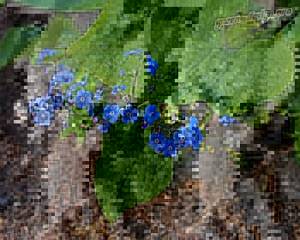
False forget-me-not is the second equally popular name for Brunnera. It is a prominent representative of perennial plants, flowering in the first half of spring. Fleshy greens and bright blue-violet inflorescences will be a wonderful decoration for a flower bed. Brunnera is a slow-growing plant that prefers to grow in light or partial shade. Blooms profusely for about a month. For its intensive growth, fertile, well-drained soil is preferred.
Christmas rose
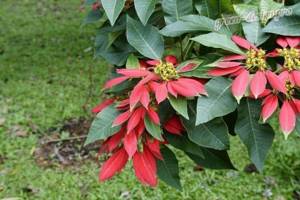
Perennial flowers in early spring are always pleasing to the eye. And one of these colorful representatives is the Christmas rose or Hellebore. This plant has beautiful large buds consisting of snow-white petals, connected together they visually resemble the bud of a delicate rose. Lush greenery frames graceful inflorescences. Refers to highly ornamental plants, used in single and group plantings. Blooming at the very beginning of March, the Christmas rose delights with its beauty and tenderness. Prefers moist, nutritious soil, as well as a semi-shaded planting site. Hellebore is characterized by slow growth and great species diversity.
The above-mentioned perennial flowers of early flowering do not exhaust the entire color diversity of this period, but they also make it clear that early spring can be made colorful.
Annuals - variety in everything
Annual plants, which can be replaced every year, will add special variety to spring flower beds. The most optimal option is to plant already flowering seedlings between faded bulbous plants - then the flowerbed will not lose its aesthetics even for a week. Among annual plants combined with bulbous and sophisticated spring perennials, pay attention to purslane, lobelia, phlox, etc. Almost all annuals are characterized by long flowering and will decorate the flowerbed throughout the warm season, right up to frost. In this case, the spring flower garden will gradually turn into a summer one, without suffering at all aesthetically.

Biennial plants, for example, pansies, are also actively used in spring flower beds.
Selecting plants for spring flower beds, combining them, and experimenting with varieties and hybrids can be an exciting experience. Just as an artist applies fresh strokes of paint to a canvas, you can add different spring plants to your flower garden, welcoming spring in a new way every year.
A few words about blueberries
Many people associate the flowering of woodlands with the onset of spring. They are inhabitants of forests, which are capable of forming something like sky-blue lakes in forest clearings. Planting these spring primroses in gardens and cottages is also popular. They are planted with rockeries and alpine slides. Blue-colored woodlands look great on lawns when still bare bushes and trees grow around them.
Siberian scillas, which bloom at the end of March, are very famous. Scilla blooms with piercing blue bell-shaped flowers. There is a much greater variety of varietal plant species, which can have white, blue, purple and soft pink colors.

Blooming blueberries.
Scillas are bulbous perennials, non-capricious and independent plants, which are best planted on the canopy of orchards in loose and fairly fertile soil.
The plant can reproduce well by self-sowing; you can also use dividing the bulbs for this. They are distinguished by their ability to grow on one piece of land for many years in a row. They are winter-hardy, however, during the winter, cover the area where the scillas are planted with fallen leaves.
Spring flowers with photos and names
Such a beautiful holiday as Women's Day pleases with an abundance of beautiful flowers, among which tulips, of course, take the lead. However, this is a greenhouse beauty, because it will not bloom in the garden until May. Considering that in most regions there may be snow before the end of March, it is too early to talk about decorating a flowerbed.
Therefore, you can either grow tulips on the windowsill, or wait a little. After all, it all begins with the April violet, passing the baton to garden tradescantia, lupine, tulips, daffodils and other delicate representatives of the flora.
First of all, I would like to pay attention to low-growing flowers that can weave a huge flower bed. The following flowers for the flower bed will delight you with lush and bright blooms.
Gypsophila repens
During the flowering period, this plant is covered with a huge number of small peduncles, and in the summer it simply decorates the flowerbed with fresh green leaves. If you plant gypsophila in a small pot, it will grow like a lush “standing” bush.
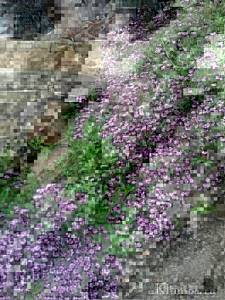
Gypsophila repens
In the flowerbed she spreads herself out as best she can. It is worth noting that she does not like waterlogging and gravitates towards dry, sunny areas.
Carnation low growing
Lightness, elegance and an unimaginable aroma best characterize this look. The bush reaches 15 cm in height and grows “single”.
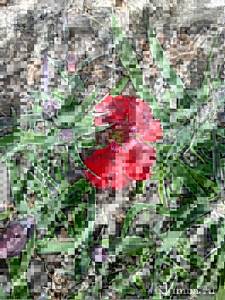
Therefore, to decorate a border or a curly path, it is necessary to propagate carnations by seeds or vegetatively divide the bushes, planting them at a short distance.

Carnation low growing
Yasnotka
It attracts not so much with its peduncle, but with its light leaves and ability to reproduce quickly. Although it is hardy and can easily tolerate heat, it is best planted in cool, shady areas.
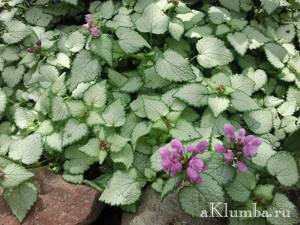
Yasnotka
Poultry farmer
This beautiful, graceful milky flower can grow up to 50 cm, however, in shady places its height rarely exceeds 25 cm. At the same time, it will delight you with many flower stalks.
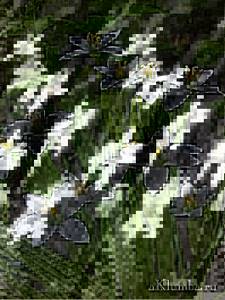
If you want to give your flowerbed some personality, you should add several unusual representatives of the beautiful flora there.

Poultry farmer
Wild onion
It can be large or small. During flowering, the first shoots an arrow up to 1 m high, at the end of which there is a huge purple ball, the structure of which resembles a faded dandelion. The second is a low bush with many graceful pink flower stalks.

Wild onion
Wild garlic
Another good choice for decorating the border or “background” of a flower bed. In appearance, this plant very much resembles small wild onions, only the flower is slightly different. By the way, this type is often used to create alpine slides.
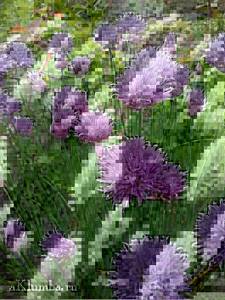
Wild garlic
Lupine
Admirers of the color purple will not pass by this plant, reminiscent of luxurious bunches of grapes. Lupine or “wolf bean” comes in several varieties, but the most beautiful is still purple. The best “neighbors” for it will be lilies, phlox, irises and delphiniums.
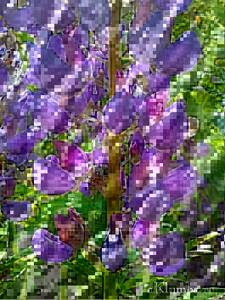
Pyrethrum
In fact, this is a colored chamomile, which is distinguished by its unpretentiousness and early flowering. Interestingly, this plant contains pyrethrins - substances that help get rid of bedbugs. Therefore, dried flowers can be spread in the basement or in other places where these insects are found.
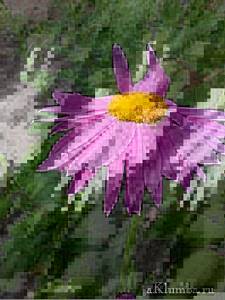
Pyrethrum
Milk thistle
This plant is so simple and unpretentious that many for a long time perceived it exclusively as a weed. But it soon gained popularity in the design of urban flower beds, which are difficult to care for regularly. Therefore, this is a good plant for decorating an area behind a fence - no one will definitely tear it out, and it looks better than ordinary grass.
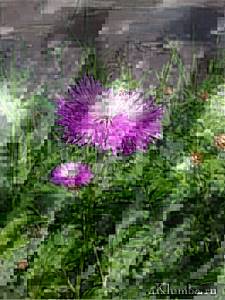
Milk thistle
Tradescantia garden
It is interesting that this bush blooms at different times - for some in early May, and for others only in June. Much depends on the landing site. Although it prefers partial shade, flower stalks appear earlier in the sun.
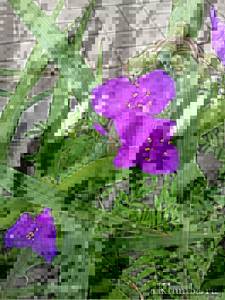

Tradescantia garden
Of course, all the flowers presented above are beautiful and original in their own way, but they cannot be called independent in terms of design, since not everyone likes them. Most often, they only surround those representatives of the flora whose beauty defies skepticism. Speaking about spring flowers - the leaders, it is worth mentioning daylilies, peonies, irises, tulips and daffodils.
Form a flowerbed according to your preferences, and it will become a magical piece of a fairy tale on your site.
The earliest spring flowers in my garden
White primroses
In small thawed areas among the loose wet snow that has begun to turn grey, white, blue, blue, purple, and yellow delicate first flowers look elegant and sophisticated. As soon as it gets warmer, other colors will appear, but these are typical for early spring in the natural environment.
Related article:
From one petunia bush I cut ten
The white color of the petals is due to the fact that next to cells without pigments, i.e. transparent, there is empty intercellular space, therefore, when sunlight is reflected, the eye perceives the surface as white. If you press on the petal, the air will come out and you will immediately notice that the petal is not white, but transparent. It is believed that white color protects against excess ultraviolet radiation, the excess of which can damage DNA.
Anemone or anemone
The plant got its name from the word “anemos”, which translates as “wind” - even in a weak breeze, the stems and leaves tremble and sway in the direction of the air flow. The natural habitat of the herbaceous perennial is the temperate zones of the Northern Hemisphere and the Arctic.
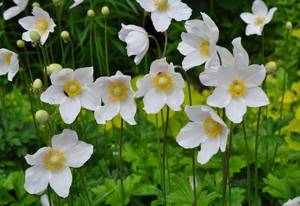
Crowned and tender anemone is found on bright sunny edges and lawns; other species prefer shaded and wind-protected areas of a forest, park, mountain slope, hill, or ravine. The culture is listed in the Red Book because it is slowly disappearing under the influence of civilization.
Related article:
Growing sunflowers from seeds
The rhizome of the anemone quickly grows in width, so usually the flowers occupy a large area and do not grow one by one. Depending on the variety, the height reaches 25 cm or more. A leaf of bright shades of green, with small serrations, is located at the top of the stem.
Each stem has only one flower with six white petals and a yellow center. Artificially bred varieties have blue and purple petals. Primrose begins to bloom in the first half of May.
Spring whiteflower (Leucojum vernum)
In nature, white-flowered plants have chosen wet areas of meadows and fields, mountain slopes, edges of deciduous forests, and beech forests of Central and Southern Europe. The root system is represented by a small (up to 3 cm) bulb and roots, which partially die after the end of the active growing season.
Related article:
How to grow fireweed at home, on your own plot

The basal leaf, narrow and long (15 cm), is formed simultaneously with the bud. The flower on a long (up to 30 cm) peduncle is shaped like a white bell of six sepals (2.5 cm long), the top of which is decorated with a yellow or light green spot. The flowering period depends on the climate of the area - in some places it lasts from mid-April to mid-May, in others it comes later. The seeds ripen by the end of June.
The aerial part contains biologically active substances that have a positive effect on coughs, diseases of the nervous and musculoskeletal systems. It is necessary to use white flower for medicinal purposes on the recommendation of a doctor, since it also contains toxic substances.
Galanthus or snowdrop (Galanthus)
Snowdrop flowers are associated with early spring, warm spring sun, thawed patches in the snow. The Russian name is connected precisely with their peculiarity of appearing from under the snow when nature is just beginning to wake up. Snowdrops are found in the central and southern regions of Europe, in the Caucasus and do not live long - only a month.
Related article:
Marigolds - beneficial properties, planting and care
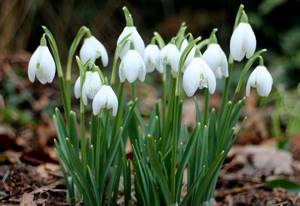
The plant is not tall, the leaves (2-3 of them) are narrow, located in a ground bunch, and begin to grow simultaneously with the buds. At first they are shorter than the peduncle, but after flowering they grow up to 10-20 cm. A beautiful snow-white flower is formed on a long cylindrical peduncle, its three perianth leaves are wide, snow-white, and on the three inner, smaller ones, there are greenish spots in the upper part .
Hellebore or winterweed (Helleborus)
The Russian name of the flower speaks for itself - hellebore begins to bloom in early spring, when not all the snow has melted. The color of the petals is different - greenish, white, pinkish with a slight shade of red, cream. Caucasian (eastern), black, and bush hellebore have white ones.
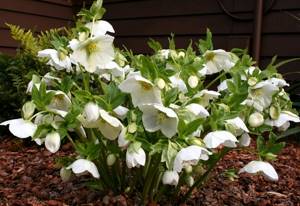
The basal leathery leaf is different in shape - palmate or stop-shaped. By the end of flowering, they form a beautiful, neat, low bush. The flower of these species is large, with white sepals and yellowish nectaries, and holds its shape for a long time. Primrose, spring crocus, and scilla bloom together with the hellebore, but when they bloom, they “go away,” and it, having grown new leaves, flaunts itself until autumn.
Related article:
Unusual fertilizers for hydrangea - kefir and more
Poetic narcissus or white narcissus (Narcissus poeticus)
This species is naturally found in the southern regions of Europe and Asia. On its basis, varieties have been bred for cultivation in the middle zone. The root system is a bulb. Depending on the climate, it blooms in March-early June.
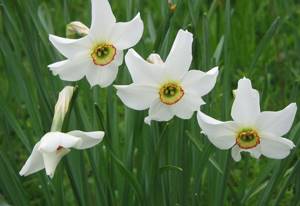
The basal leaf is flat, narrow (up to 1.5 cm), with a bluish coating, and shorter than the peduncle. On a long (up to 45 cm) peduncle, one fragrant large (3.5-7.5 cm) flower with snow-white perianth petals and a bright yellow center is formed.
Ornithogalum
The genus is represented by winter-hardy bulbous plants with a height of 10 to 90 cm, growing in the temperate and subtropical climates of Europe, Africa, Asia, America, Western Siberia, and the Caucasus. Fragrant, delicate flowers appear when nature does not yet have bright colors, so they look like a spring decoration in the forest.
Related article:
Varieties and types of perennial asters
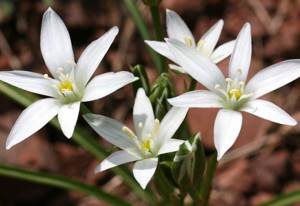
The leaf is basal, linear or belt-shaped, with a whitish longitudinal vein in the center, appears before the peduncles. In some varieties, leaves grow in the fall, persist until spring, and die off in the summer. The petals of the flowers, collected in a racemose or corymbose inflorescence, are white or pale yellow, with a light green stripe on the outside.
